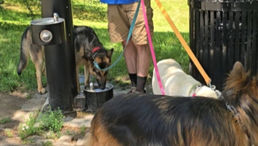10 Helpful Winter Safety Tips to Know for Dogs
- Mikaeel Malik

- Mar 3
- 3 min read
Updated: May 19

Winter brings snowy landscapes and cozy nights, but for our furry friends, it also comes with hidden dangers. From freezing temperatures to salty sidewalks, keeping your dog safe during the colder months requires extra care and preparation.
These 10 essential winter safety tips will help ensure your pup stays comfortable, healthy, and happy all season long!
Tip #1 - Paw Protection
Proper paw protection for your pooch. Winter can be harsh on our furry friends' paws, try paw wax or winter booties for dogs to help prevent irritated or chapped paws.

Tip #2 - Dress for the Weather
Young, old, small, sick, and short hair dogs all can struggle with cold weather. If temperatures are dropping sweaters are an affordable and fashionable way to keep your pup safe in the winter.
Tip #3 - High Visibility Gear
With snowy weather comes shorter days, making it even more important to keep your dog visible. High visibility gear isn’t just a winter essential but also a must have piece of gear when hiking or camping as well.
Tip #4 - Pet Safe Ice Melt
Using pet safe ice melts in your own yard is an easy way to ensure your pups paws don’t become irritated, leading to discomfort and possibly infection.
Tip #5 - Avoid Over Bathing
Over bathing can strip the essential oils from your dogs skin leading to dry skin and other irritation, instead try using a dog safe dry shampoo.

Tip #6 - Proper Grooming
Each dog’s grooming needs will vary and should be carefully determined. Nail trimming, teeth brushing, and ear cleaning are great all season practices but winter brings its own challenges. Some dogs might require frequent trimming around the paws to keep ice and salt build-up down, some dogs have a double coat and special care must be taken to not damage the under coat as it helps to regulate your pups temperature. Consult your groomer for best practices.
Tip #7 - Diet Changes
How should you build a winter diet for your dog? Dogs that spend more time outside might need a calorie increase to be able to maintain body heat in low temperatures. Dogs that spend more time inside might need an overall decrease in calories to prevent too much weight gain during low activity winter months. However much you’re feeding your pup, make sure that they’re reaching their nutritional goals for their age and breed.
Tip #8 - Signs Of Frostbite And Hypothermia
How cold is too cold for dogs? Keep an eye out for a few signs; including whining, shivering, slow movements, and blue-tinged skin. If you see these signs bring your dog inside into a warm area, wrap them a blanket, and place a lukewarm water bottler within the blanket leaving a few layers of fabric between it and the pup. This helps warm them back up without causing more damage to the already affected and sensitive areas.

Tip #9 - Outdoor Dog Shelter Winter Safety Tips
Dogs that spend a significant amount of time outside must have access to adequate shelter. Make sure their shelter is wind proof and dry, changing the bedding if it gets wet and doesn’t dry quickly. Avoid using metal water bowls as your pup might become stuck. Make sure your furry friend is able to alert you if they need to return inside.
Tip #10 - Vehicle Leakages
With snow and ice trapping vehicle fluids and not allowing them to be washed away be wary of your pet accidentally consuming any. Antifreeze in particular is very tasty to our canine companions and is also unfortunately extremely toxic, contact your local poison control if you think your dog has consumed any vehicle fluids.
A Little Preparation Goes a Long Way for a Safe Winter!
Winter can be a magical time for both you and your dog, but it’s important to take the right precautions to keep them safe from seasonal risks. By following these winter safety tips, you can protect your pup from frostbite, dry skin, irritated paws, and other seasonal risks while ensuring they stay safe and comfortable. With the right care and attention, you and your furry friend can make lasting winter memories!
BONUS Tip!
Elderly dogs may have arthritis or other joint issues leaving them vulnerable to cold weather. Extra bedding, decreased exposure time, and possibly even a heated bed are great ways of keeping our best friends comfortable during the long winter months.
Further Reading
If you’re interested in further reading here are a few sources we found very helpful.
The Humane Society - Keeping Pets Safe in Cold Weather
ASPCA - Cold Weather Safety Tips
AVMA - Cold Weather Animal Safety












Comments